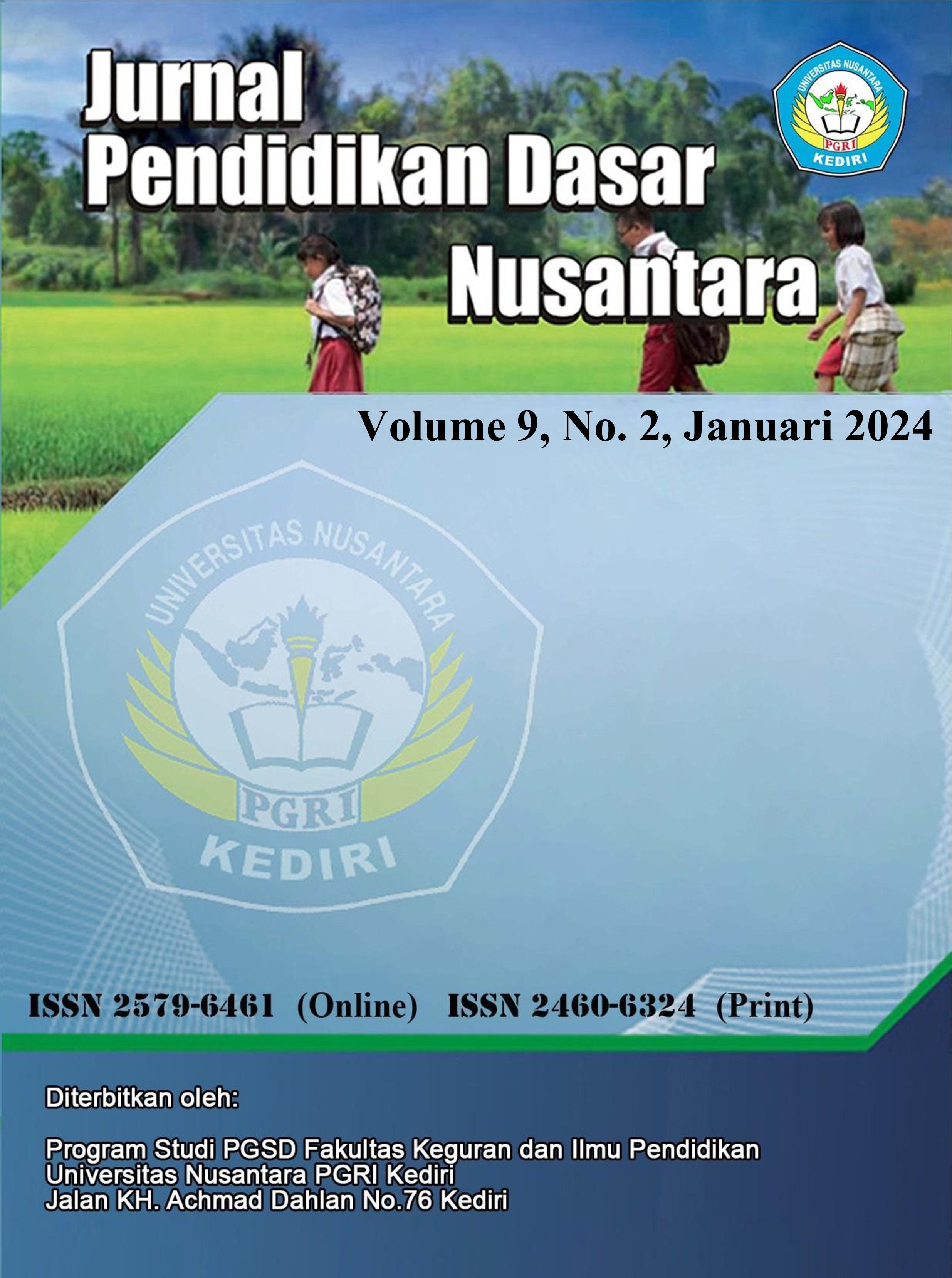Development of website-based teaching materials on the solar system for class V elementary school students
DOI:
https://doi.org/10.29407/jpdn.v9i2.21834Keywords:
Teaching Materials, Websites, Solar SystemAbstract
The aim of this research is to develop website-based teaching materials on the solar system for fifth grade elementary school students. This teaching material was developed as a learning resource in elementary science learning which was developed systematically and logically. The method in this research uses R&D by adapting the ADDIE development model with stages, namely: 1) Analysis, 2) Design, 3) Development, 4) Implementation, and 5) Evaluation. The location of this research was carried out at Emmaus Elementary School, Kediri Regency with a total of 25 test subjects. The data used to see the feasibility of the product that has been developed is product validity data, product practicality data, and product effectiveness data. The results of product validity tests carried out by material experts obtained an average value of 85%, while the validity results by design experts were 83%. The average product validity test result is 84% with valid criteria. The level of practicality and effectiveness of the teaching materials was carried out through extensive trials with the product practicality level obtaining an average score of 96% in the very practical category. Meanwhile, the results of the product effectiveness test can be seen from the comparison of the average value of classical student learning outcomes, namely 80 with a KKM of 75. Based on the comparison results, the average classical student learning outcomes are higher than the predetermined KKM, so the product can be declared effective for use in teaching. solar system material for fifth grade elementary school students.
Downloads
References
Akmalia, D. (2021). Pengembangan Bahan Ajar Digital Berbasis Android pada Materi gerak lurus di SMA, UIN Ar-Rani Banda Aceh [Skripsi]. Retrieved from: https://repository.ar-raniry.ac.id/id/eprint/16029
Alwi, Z., Ernalida, & Lidyawati, Y. (2020). Kepraktisan Bahan Ajar Perencanaan Pembelajaran Berbasis Pendidikan Karakter dan Saintifik. Jurnal pendidikan bahasa dan sastra indonesia, 16(1), 10-12. https://doi.org/10.25134/fjpbsi.v16i1.2312
Firdian, F., & Maulana, I. T. (2018). Pengembangan Media Pembelajaran Multimedia Interaktif pada Matakuliah Aplikasi Software. Jurnal Pendidikan: Teori, Penelitian dan Pengembangan, 3(6), 822–828. Diambil dari http://jounal.um.ac.id/index.php/jptpp/
Hasugian, PS (2018). Peranan website sebagai media promosi dan informasi. Jurnal Informatika Pelita Nusantara , 3 (1).
Hidayah, D. N., & Priscylio, G. (2019). Pengembangan Bahan Ajar Mandiri Pokok Bahasan Suhu Dan Kalor Menggunakan Software Camtasia. Journal of Teaching and Learning Physics, 4(1), 50–64. https://doi.org/10.15575/jotalp.v4i1.4093
Kementerian Pendidikan dan Kebudayaan. 2013. Pedoman Kegiatan Pendampingan Implementasi Kurikulum 2013 bagi Pengawas Sekolah, Kepala Sekolah, dan Guru Inti. Jakarta: Pusbang Tendik Kemendikbud.
Putri, I. S., & Kelana, J. B. (2022). Pengembangan Bahan Ajar Pada Materi Tata Surya Dengan Menggunakan Model Student Teams Achievement Division Berbantuan Aplikasi Solar System Scope Dan Book Creator Untuk Meningkatkan Pemahaman Konsep IPA Kelas VI Sekolah Dasar. Jurnal Profesi Pendidikan (JPP), 1(2), 67-81.
Pratiwi, S. I., & Wahyudi, W. (2021). Pengembangan Bahan Ajar Tematik Berbasis Website untuk Peserta Didik di Sekolah Dasar. Edukatif: Jurnal Ilmu Pendidikan, 3(2), 333-340.
Rosyid, Khakam (2019) Pengembangan Bahan Ajar Praktik Mata Kuliah Inspeksi dan Tes di Program Studi D3 Teknik Elektro Fakultas Teknik Universitas Negeri Yogyakarta [Tesis]. Retrieved from: Https://Eprints.Uny.Ac.Id/6258
Rusman. 2020. Pembelajaran Tematik Terpadu: Teori, Praktik, dan Penilaian. Jakarta: Rajawali Pers.
Saputri, A. H. (2020). Pengembangan Bahan Ajar Berbasis Budaya Lokal Kalimantan Barat untuk kelas IV Sekolah Dasar Negeri 58 Kecamatan Sungai Raya Kubu Raya [Skripsi]. Pontianak: Universitas Tanjungpura.
Sojayapan, C., & Khlaisang, J. (2020). The effect of a flipped classroom with online group investigation on students' tearn learning ability. Kasetsart Journal of Social Sciences, 41(1), 28-33. https://doi.org/10.1016/jkjss 2018.02.003
Suniasih, N. W. (2019). Pengembangan Bahan Ajar Neurosains Bermuatan Pendidikan Karakter dengan Model Inkuiri. Mimbar Ilmu, 24(3), 417. https://doi.org/10.23887/mi.v24i3.22542
Susilowati, Y. (2019). Modul Pabrik Pengajaran e-Commerce untuk siswa . Penerbit Mutiara.
Tanjung, & Nababan, S. A. (2018). Pengembangan Perangkat Pembelajaran Matematika Berorientasi Model Pembelajaran Berbasis Masalah (PBM) untuk Meningkatkan Kemampuan Berpikir Kritis Siswa SMA SeKuala Nagan Raya Aceh. Genta Mulia, 9(2), 56–70.
Umam, Khoerul, Nusantara, T., Parta, I. N., Hidayanto, E., & Mulyono, H. (2019). An Application of Flipped Classroom in Mathematics Teacher Education Programme. International Journal of Interactive Mobile Technologies (IJIM), 13(03), 68. https://doi.org/10.3991/ijim.v13i03.10207
Widoyoko, E. P. (2018). Teknik Penyusunan Instrumen Penelitian. Yogyakarta: Pustaka Pelajar.
Downloads
Published
Issue
Section
License
Authors who publish with this journal agree to the following terms:
- Copyright on any article is retained by the author(s).
- The author grants the journal, the right of first publication with the work simultaneously licensed under a Creative Commons Attribution License that allows others to share the work with an acknowledgment of the work’s authorship and initial publication in this journal.
- Authors are able to enter into separate, additional contractual arrangements for the non-exclusive distribution of the journal’s published version of the work (e.g., post it to an institutional repository or publish it in a book), with an acknowledgment of its initial publication in this journal.
- Authors are permitted and encouraged to post their work online (e.g., in institutional repositories or on their website) prior to and during the submission process, as it can lead to productive exchanges, as well as earlier and greater citation of published work.
- The article and any associated published material is distributed under the Creative Commons Attribution-ShareAlike 4.0 International License

































